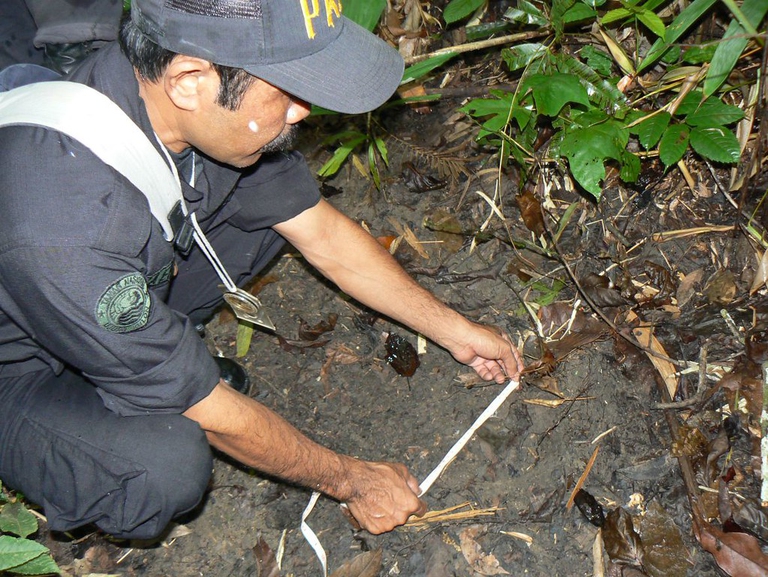
Our species took its first steps in a world covered in trees. Today, forests offer us sustenance, shelter, and clean the air that we breathe.
The critically endangered population of the Javan rhino in Indonesia has risen to 72 individuals, as four new calves are registered thanks to camera traps.
The discovery of four Javan rhinos (Rhinoceros sondaicus) is truly extraordinary news for a species currently classified as “critically endangered” by the IUCN’s Red List. It represents a glimmer of hope in the otherwise gloomy prospects for the future of these mysterious and fragile giants of the forest.
Once widespread throughout all of Southeast Asia, Javan rhinos have suffered a tragic decline mainly due to poaching and deforestation. The surviving specimens have been reduced to inhabiting only Ujung Kulon National Park, located on the westernmost tip of the island of Java, in Indonesia.
In this national park, four young previously unregistered specimens were catalogued by researchers with their camera traps. As a result, the overall rhino population has increased from 68 to 72 individuals. “We’re excited to see new births taking place in Ujung Kulon,” as stated by the International Rhino Foundation (IRF). “Surpassing a population number of 70 Javan rhinos is a significant milestone”. An official from the Indonesian Environment Ministry clarified that the calves had different mothers and had all been identified within the park boundaries.
Read more: Another giant has left us: the Sumatran rhino is extinct in the wild in Sabah
Javan Rhino Increases to 72 in Latest Count https://t.co/BmbSpQlUYh pic.twitter.com/Ma0NTGUxF2
— IntlRhinoFoundation (@RhinosIRF) December 6, 2019
It’s thought that ten years ago there were only 50 rhinos living in the Indonesian park. The long-term policies and efforts of rangers, park managers, officers and NGOs have paid off and the population has gradually increased as a result. Measures have been implemented to stop all poaching and illegal activities. In addition, those in charge of the area have found various ways to help sustain the mammal’s population growth. For instance, invasive alien plant species have been removed to favour the growth of the plants rhinos naturally feed on.
Badak Jawa (Rhinoceros sondaicus) yang tadinya tersebar di banyak wilayah, kini hanya ada di Taman Nasional Ujung Kulon. #WorldRhinoDay #Connect2Wildlife #Connect2Earth #NatureMatters #TogetherPossible #SurvivinginSilence pic.twitter.com/XUeHRYXOkb
— WWF-Indonesia (@WWF_ID) September 22, 2019
Experts have noticed a stable increase in the rhino population thanks to the adopted measures. According to the IRF, there have been no recorded cases of poaching in the last 20 years. On top of this, at least one calf has been born every year since 2012. However, despite the encouraging data, the species is still in danger and faces a number of threats. These range from the potential risk of infectious diseases (possibly fatal within such a small population), to the impact of human activities and natural disasters. In fact, their habitat is located in the danger zone of a possible eruption by Anak Krakatau volcano.
Experts claim Ujung Kulon park, which covers an area of only 480 square kilometres, can’t sustain more rhinos than those currently inhabiting it, dampening hopes of constant population growth. Furthermore, the reserve was hit by the 2018 tsunami, an event that exposed the vulnerabilities of the rhino’s sole existing habitat. In response, the Indonesian government has started searching for a second site in the hope of establishing a new rhino population. However, this initiative has currently been suspended in favour of an expansion of the territory available to these animals within Ujong Kulon.
Inspired by the species’ scientific name, Rhinoceros sondaicus, Project Sondaicus is a student-led initiative to preserve endangered Javan Rhinos by preserving its habitat, which they hope to encourage through the spreading of awareness https://t.co/oCpJkiUgcS pic.twitter.com/0F7yf6fKpj
— Save the Rhino (@savetherhino) October 19, 2019
“Undoubtedly there’s more work to do,” affirms Cathy Dean, CEO of Save the Rhino International, “continuing to protect and monitor the rhinos within Ujung Kulon, as well as looking for a second, suitable site, so that we don’t have all the world’s Javan rhinos in one ‘basket’. Only 50 years ago, the entire Javan rhino population was thought to number between 21 and 28 individuals. The increase to more than 70 animals today is a huge achievement, giving everyone hope that with sustained, strategic efforts, Javan rhinos, and other critically endangered rhino species, can thrive.”
Siamo anche su WhatsApp. Segui il canale ufficiale LifeGate per restare aggiornata, aggiornato sulle ultime notizie e sulle nostre attività.
![]()
Quest'opera è distribuita con Licenza Creative Commons Attribuzione - Non commerciale - Non opere derivate 4.0 Internazionale.
Our species took its first steps in a world covered in trees. Today, forests offer us sustenance, shelter, and clean the air that we breathe.
Poachers in Africa are encroaching on wildlife land and killing rhinos in travel hot spots now devoid of visitors due to the coronavirus pandemic.
Actor and environmental activist Leonardo DiCaprio has contributed two million dollars to a fund to protect Virunga National Park in Congo from threats such as terrorism, the coronavirus and poaching.
For the first time in seventeen years, Iceland’s two main whaling companies won’t resume whale hunting. The announcement concerns this year’s season but could carry into the future.
The relationship between the coronavirus and wildlife is complex: while the pandemic may lead to a reduction in the illegal trade in wild animals, it may also encourage it in other respects.
The largest coral reef in the world is severely threatened by climate change, but researchers are developing strategies that could contribute to saving the Great Barrier Reef.
NGO Free the Bears has opened a mountain sanctuary for moon bears in Laos. With the government’s help, it aims to close all bile farms by 2022.
Seychelles have extended its marine protected area, which now covers over 400,000 square kilometres, an area larger than Germany.
The tapir was reintroduced into Brazil’s Atlantic Forest, the country’s most at-risk ecosystem. The species can play a key role in the forest’s recovery.








